#Language of change
Explore tagged Tumblr posts
Text
Studying linguistics is actually so wonderful because when you explain youth slang to older professors, instead of complaining about how "your generation can't speak right/ you're butchering the language" they light up and go “really? That’s so wonderful! What an innovative construction! Isn't language wonderful?"
#linguistics#gen z slang#english#as people in the reblog pointed out!#most gen z slang comes from (or was appropriated from) aave#honestly I was just excited to talk about how people in my field actually get excited about non standard uses of English#instead of ridiculing speakers#and I tagged incorrectly and didn’t point out the very real issues of language and power and appropriation inherent in modern slang#in that much of it was appropriated#and even that which experiences language change in the wider culture still originated in aave#aave is just as linguistically valid as any other English dialect because it is a proper language#and the grammar is incredible!!!#habitual be is fantastic and an excellent example of how a richer case system or a certain case can render an adverb unnecessary#and the phonology is just beautiful#anyway I’m very sorry#I fucked up
29K notes
·
View notes
Text
We're not appreciating the Weird Barbie enough. It's said in the movie that she helps everyone who need help while they always see her as someone who's not as good as them. She was friends with all dismissed Barbies and Kens, was there to offer support and safe shelter for everyone who needed it in Kendom, without her nothing in the movie would've been alright. When Stereotypical Barbie calls her "ugly and unwanted" she still helps her.
She was representing a woman in women's world who was pushed aside by other women because she didn't fit in but still had more wisdom and kindness than everyone who thought they're better than her.
#weird barbie#barbie#Barbie movie#everyone looks at her as a queer person i see her as me I'm a straight person who got bullied simply for being different than the rest#but it's beautiful that we all see ourselves in her whatever our story is#cuz that's the point of characters like her#i changed wisness to wisdom sorry english isn't my first language and i forgot which one is more correct
47K notes
·
View notes
Text



Bluest hour.
Originally a bw lighting study but i played around and found blue prettier. Anyway here’s the bw version because i like it too.

#myart#jjba#leone abbacchio#i was watching jjba dub in my native language the other night and i miss my goth husband#vento aureo#yes my art style changed👉👈
3K notes
·
View notes
Text
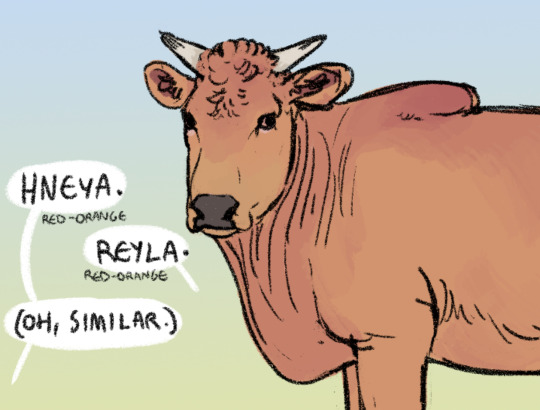

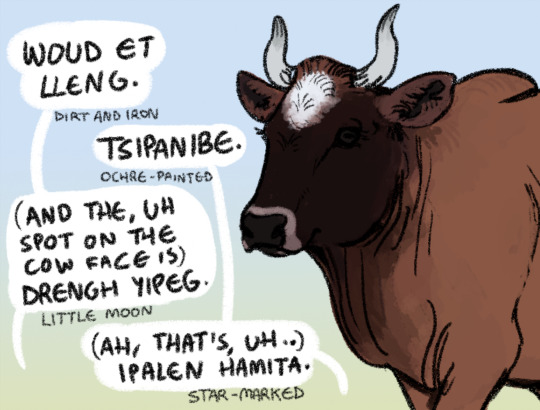
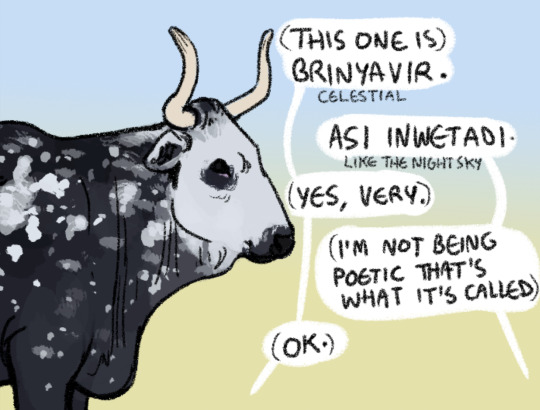
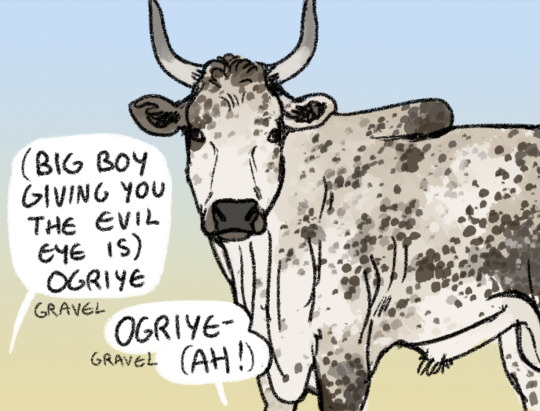
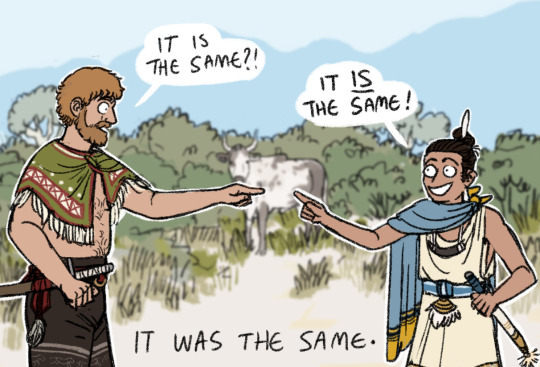
Comparing livestock color-words.
Both the Chenahyeigi and Wardi languages are derived from peoples who have been pastoralists for millennia, and both have an absolute ton of words for livestock coloration.
Both languages have had at least some mutual influence for about a thousand years (to varying extents by dialect, depending on geography/trade connection) so you'll see similar or identical words crop up here and there.
THE WORDS:
Hneya - [hne:ʝɑ] or [hne:jɑ] (whether the ʝ sound is retained in speech and to what extent varies by dialect)
Straightforwardly refers to bright reddish-orange color, but is mostly used for animals rather than other orangeish things. The word Was probably influenced by an older form of the Wardi 'reyla', and absorbed with the introduction of orange colored cattle. It may have been merged with the Chenahyeigi '(h)ne', which is the root of several red color-related terms.
Reyla - [rejlɑ]
This is a Wardi word for most reddish-orange hues in general. When applied to livestock, it refers to solid orange coats without spotting/masks/notable countershading.
Fels akhri - [fels] [ɑ:khɾi]
Translates readily as 'storm cloud' (the 'storm' here specifies thunderstorms). When applied to livestock, it describes fur that is rich dark blue-gray with white guard hairs.
Aganne - [ɑgɑ:ne]
This doesn't actually translate to 'night sea' in a straightforward manner, but as a color word it's poetically associated with dark seas, at night or in storms. When used for livestock, it describes this coloration exclusively.
Woud et lleng - [woʊd] [ɛt] [ɬeŋk]
Woud is the word for rich moist soil specifically, lleng refers to laterite and its association with iron deposits. This phrase is used to describe livestock with dark brown heads and and orange-brown bodies.
Tsipanibe - [t͡sipɑnibe]
This would be more literally translated as 'ochred'. Many Wardi words with the -ibe stem from verbs or nouns modified to indicate that the subject matter has 'received' an action or concept. (Examples of such words are long-established linguistically, you can't just add '-ibe' to any noun or verb). This one takes the root 'tsipan' (ochre) and applies it to the subject matter (cattle coloration).
Livestock with a dark brown or black head and orange-brown body are given this description, the idea being that their bodies look like they've been painted in ochre. This word is extremely rare outside of this context (you would usually just say the full 'ochre-painted' to convey this idea for other things)
Drengh yipeg - [dɾeŋg(h) yɪpɛ:g]
This is pretty straightforwardly 'little moon'. Yipeg comes from the same root as the Wardi 'hippe' for 'small', while drengh refers to the appearance of the moons in the sky (rather than the gods they embody). It's used to describe small round white blaze marks.
Ipalen hamita - [ipɑlɛn (h)ɑmitə]
Straightforwardly 'star marked', used for small round white blaze marks. Wardi actually does have a 'moon marked' (ipalen amit) to describe round white blazes that entirely cover the animal's forehead.
Brinyavir - [bɾi:nʝɑvir] (ʝ is retained for this word in most dialects)
This one is not directly translatable, 'celestial' or 'heavenly' just function closely enough. The word conceptually relates to stars but most specifically describes a layer of sky in which the afterlife rests (brinyavir is part of the phrase I translate as 'celestial fields'). The cattle there are said to have these markings. The stars in the night sky are sometimes playfully described as the spots of these cattle (though not literally, in Chenahyeigi cosmology stars are spirit-inhabited bonfires lit along pathways through the heavens).
As a color word for livestock, brinyavir refers to this rare (I Think nonexistent irl) white-spotted black coloration, due to both resembling the stars and the cattle that are moved among them.
Asi inwetadi - [ɑsi in:wetɑ:di]
This directly means 'like night sky', and is applied to this coat pattern with a similar underlying logic- it looks like a starry night sky. You will often see asi (like/akin to) retained in place or animal names like this, and it is sometimes part of names for people (the name Asinya is derived from a contracted 'like the sun').
Ogriye - Chenahyeigi: [oʊ:gɾije] Wardi: [oʊgɾi:je]
This word is (or was) a way to say 'gravel' or 'gravelly' in both Chenahyeigi and Wardi, and is pronounced very similarly in both (with the only significant difference being emphasis)
In Chenahyeigi it is a loanword from the Wardi language family, most likely received in the exchange of cattle of this coloration. It is retained in general speech as a word for gravel, more specifically the adjective 'gravelly'.
The word is mostly obsolete in contemporary Wardi, speakers do not know it used to mean 'gravel' (though it sounds close enough to assume a connection, the word is 'ogri') and exclusively use it to describe this livestock coloration (one of the more common among Wardi native cattle).
---
Also here's some cow lore.
There's some fairly tremendous diversity in Wardi cattle herds, given they have genetic influence from at least two separate aurochs domestication events (also distant and negligibly minor influence from one instance of bison domestication) and from multiple relatively isolated domestic cattle populations. Present day herds within Wardi provincial territory near-ubiquitously have at least some ancestry from the kulustaig and the Burri tepang cattle.
The ancestors of the Wardi native cow have been in the region for at Least 5,000 years. Burri cattle Possibly could have had tiny, isolated introductions between 2500-3000 years ago (this is extremely unlikely, but maize Was probably introduced by seafaring proto-Burri peoples at this time) or at more recent points since, and the tepang was certainly introduced during Imperial Burri occupation. High quality cattle are also occasionally received in diplomacy with the present-day Different Entity that is the Burri Republic. The kulustaig cattle arrived with proto-Finnic migrants starting 1500 years ago, and is the biggest external genetic influence on Wardi herds. Small populations of Yuroma native cattle arrived with migrants 540 years ago, though these have been wholly absorbed into Wardi herds, with their biggest trace being genes for naturally polled horns. Some Finn cattle were extracted in the recent two decades of Wardi occupation, though not enough to have a noteworthy genetic impact on any herds.
Most of the cattle in this post show predominantly Wardi native cattle + kulustaig ancestry (this takes place in the Ephenni riverlands, where the ancestry of herds tends to be around 2:1). The one with the blaze has a delicate sloping muzzle that suggests Burri tepang ancestry, and also likely has a wild aurochs grandparent (the white ring around the nose is a telltale sign, as it usually vanishes within a few generations of introgression).
Diversity in color and coat pattern is culturally favored for Wardi cattle herds, and selective breeding for aesthetics is usually limited to the purpose of preserving unique coats. The average herd tends to be very colorful, though the one shown here is a bit of an outlier, the universe having mysteriously put in place perfect conditions to compare the words for a variety of coat patterns.
#My marginal comprehension of the IPA has advanced somewhat. For those who don't know : indicates the vowel/consonant beforehand#is long and () means a sound is marginal/optional/not articulated#The 'h's you see at the end of a lot of Chenahyeigi words are usually soft unvoiced exhalations and very subtle#It's part of the accent but not doing it doesn't change the meaning of the word in most cases#The Wardi language has a tendency of dropping H sounds at the beginnings of words over time/in certain dialects#(especially when followed by the [i] vowel. A lot of people pronounce hippegalga as just ippegalga) and in a lot of words#pronunciation of leading H's is essentially optional#One aspect of Wardi formal register is always enunciating these droppable H's
3K notes
·
View notes
Text
a true testament to Michael B Jordan's acting skills is that everyone i've seen talk about Sinners online is thirsting specifically after either Smoke OR Stack and generally has opinions over which twin is more attractive
#sinners#sinners 2025#sinners movie#mbj#michael b jordan#sinners (2025)#ryan coogler#smokestack twins#my husband is in love specifically with smoke. no interest in stack whatsoever#and i've seen people saying stack is more attractive but smoke is more sentimental too#and i know he changes his voice and his body language for either twin#but to that point of distinction??? if i didn't know they were the same guy it would blow my MIND to find out#i literally Know they're both mbj and i still struggle to imagine him acting against a body double or empty air#what do you MEAN the other guy isn't there#what do you MEAN BY THAT HE HANDED HIM THE CIGARETTE AND THEY PASSED THE KNIFE TOO WHAT ARE YOU SAYINGGG
1K notes
·
View notes
Text
I want to post this here too because I’ve seen it happen a few times
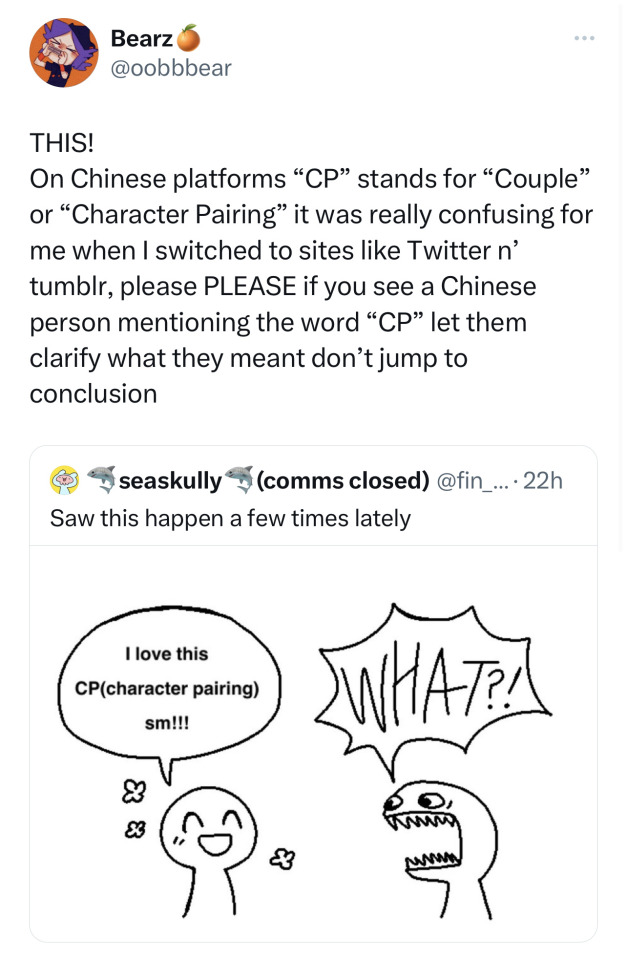
Please understand that there are cultural differences and language differences, if you see this happening let the person clarify what they meant, that person might just not be familiar with words the western side of the internet use
#bearz rambling tag#no it’s not really possible to let everyone who uses this term to change#because as far as I know this is the most common word with use on Chinese websites#I didn’t know that pairing are called ‘ship’ here#like why would I even know that#‘ship’ makes zero sense to me#it took me a while to learn the fandom language people speak here#it’s hard#give people time#shipping culture is very different too#Like on Chinese site you HAVE to clarify the Top and the Bottom of this ship in the ship name#it is very very important to them#people who like the same ship but with different Top Bottom preference will fight till no end#imagine how confused I was when I first got here#where there’s no top bottom differences#it’s not really a smut thing#it’s more a dynamic thing#AxB and BxA is very different#oh I can talk so much about the differences on fandom cultures#if ya are interested in more please feel free to ask#it’s very interesting to me#I wanna talk about it
10K notes
·
View notes
Text

#don't take that too seriously#i know some genders amd sexualities aren't really talk much about either#but it doesn't change that ace and aro are really too often forgotten#and when they are talk about its really either black or white when both ace and aro are spectrum and are really complexe#and i rarely see them well represented during pride month#pride month#asexual#aromantic#sorry for my bad English dogs it's not my first language o7
4K notes
·
View notes
Text
you know what fuck it, I love you historical spelling. I love you weird fossilised preservations of obsolete alphabets, grasping for something that exists now like mist, like liquid, its true pronunciation lost to time but not quite forgotten, not yet. a ghost remains, a friendly one, comfortable in this old house. I love you repurposed letters for phonemes that neither the old language nor the variety they were borrowed into has any need for anymore. I love you sensible vowel pairings that have grown - improbably - centuries later, into unwieldy diphthongs, quietly thriving in an ever-shifting environment like weeds nestled cosily beneath the shade of grander plants that have long since turned to mulch. I love the word 'diphthong' (the little thicket of consonants in the middle of it, sprouting up from nowhere to trouble tongue and penmanship alike). I love how Phoenician fingerprints remain in a Norman revision of an Anglo-Saxon reworking of a Roman borrowing of a Greek repurposing, all these shapes and signs moulded again and again like clay, like mud, spun like flax to carry all those lovely glides and nasals and obstruents which come and go and come and go over time as the sounds mutate and grow apart, and the people grow and age and die, leaving behind nothing except (sometimes) a page. a poem. a piece of themselves, their voice, rendered in imperfect beautiful scratchings whose contours match the ceaseless flow of time, heavy with all that history and somehow also light with the sheer urgency of being written. look at it, isn't it wonderful? this moment in time that holds within it yet other moments? other echoes calling down through the centuries? this is how we spoke, this is what we sounded like, once. this is how we thought our ancestors would have said it. I love the inconvenience. English is so hard to learn. the spelling is so illogical. so cumbersome. it's frustrating. it makes no sense. it's inconvenient. yes and yes and yes, and yet you too are inconvenient, you too are inchoate and too much and you fail to resolve into a neat and comprehensible order. but look at you. how lovely you are. I treasure you. why should the words you speak be any less lovely.
#historical spelling#English#prose poem#having a normal one#but unironically#language change#linguistics#too gay for words#pun intended
2K notes
·
View notes
Text
someone's probably pointed this out cause i'm not browsing tags but

Caleb's flower is hydrangea.
Not only a flower that changes colour in differing soil (Caleb is a chameleon or changes who is is depending on the person he's talking to or where he is?)
But the meanings are;
One sided/obsessive love, heartlessness, frigidity/coldness, apology, family and gratitude.
#wonder babbles#love and deepspace#caleb lnds#caleb#lads caleb#tumblr pls don't post stuff twice#i get easily confused#you wondered why cat curse mc learned flower language? (you probably didn't) the reason is cause i wanted to impress my friend#a long time ago and i ended up reading up so much about it#i am now a changed person and can only think about flowers with their meanings
1K notes
·
View notes
Text

playing around w slightly different hair renders
#my art#jujutsu kaisen#jjk#jjk fanart#jujutsu kaisen fanart#jjk art#yuji itadori#megumi fushiguro#itafushi#fushiita#yuuji#megumi#cries megumi fought tooth n nail..... i refused 2 flip the canvas tho >:(#i vastly prefer drawing him facing right bc fr some reason it makes his hair look better silhouette-wise#so having him face left is alr a Challenge#but also having him slightly look down (difficult angle + changes the silhouette) had me bashing my head in2 th TABLE#same thing happened earlier this month w gardening megu middle pose . i did not learn my lesson#but even worse w this one yuuji's head is blocking th main pointy part tht basically carries the entirety of the shape language#u can imagine my distress i am sure#anyway th render made me a lot happier with it thank god. colours hard carry bless <3333#i didn't plan on making it a full sheet but i needed 2 remind myself that im good at drawing megumi#so i threw in solos of each of them n tried slightly different render flavours#idk how Different all of them look visually but th process fr each ws Very different so i am satisfied#fight aside this ws useful i think! got 2 break out some Clunkier chalks n dust off a few of my smoother blended brushes#think i picked up some things i can keep also !! which ws. u kno. the Goal#tbh every time i do art studies i feel like i am kirby#one time i got called an art ditto by one of my fav artist mutuals when i did a style challenge#SUCH high praise from her it lives in my mind i take it out on days when i feel like trash#it doesnt Sound good when u say u r good at copying but real talk it is such a good skill i am very happy 2 have it in my arsenal
3K notes
·
View notes
Text
I am reminding you that h*rmaphrodite and variations thereof is a slur harmful to your intersex siblings. Stop using it.
#ra speaks#personal#lgbt#intersex#intersexism#h slur#so many well meaning* queer blogs will just casually use it while ‘supporting’ the intersex community and it’s so jarring#‘it’s medical - ‘ so is the fucking r slur but u don’t see non-ID ppl saying shit like ‘love and support r*tards <3’.#the medicalization and medical abuse intersex ppl face is hard enough stop using slurs used to perpetuate that oppression#*well meaning as in I genuinely think they support intersex rights but are ignorant and when I have mentioned it they change their language#but still I’m sure plenty of intersexists are in that rough category. listen to your intersex family or fuck off out of the queer community
1K notes
·
View notes
Link
In her new book, My Oceans: Essays of Water, Whales, and Women, Christina Rivera explores nature, the sea of language, different types of intelligence, and the power of naming the ineffable:
Though this Anthropocene dictionary is online and exists in no paper, printed, or otherwise material form, I was so strangely thrilled that I created one for myself. I printed out each word onto a notecard and stacked them on my desk. Their physical existence brings me joy, this naming of things I have felt for a lifetime, but which had no official recognition. Words like:
Neopangea, neo-pan-jee–uh: A hypothetical way of thinking the world is no longer geographically separated.
Kincara, kin-car-uh: A person of any gender who plays a loving, maternal role in raising children they have not physically birthed.
Shadowtime, shad-ow-time: The notion of a time scale in which the near future will be drastically different from the present.
Read “Quieseeds,” our exclusive excerpt from Christina’s book, on Longreads. The book is available on March 15 through Northwestern University Press.
#longreads#essay#writers#words#language#linguistics#loss#climate change#climate crisis#nature#environment#whales#sea#ocean#books
557 notes
·
View notes
Text


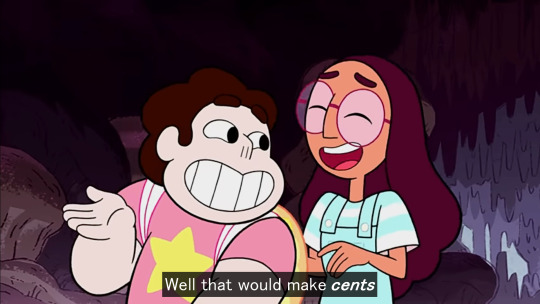
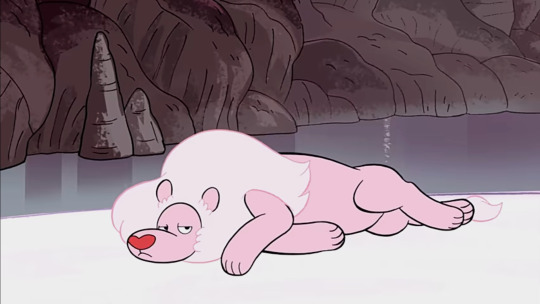
Worse is it's probably the same it make cents joke.
Draw the OTP and pun-hater by @looneyfrechie. The post itself is not loading for me so here's a reblog of that meme template in case.
#This poor old man!#Their love language is puns bruh. PUNS. 😭#connverse#Steven Quartz Universe#Connie Maheswaran#Lion SU#It was probably like. ** Of course I would need to be the one to make a change. It just make cents! ** Or something idk. 🪦#Lion 2 was such a cute episode omg#my shiz#my comics#Steven Universe#Draw your OTP#meme#comic meme#meme redraw#SU#SU comics#Steven Universe Future#comics#Their wedding vows will probably have puns in it 😭 From Steven most likely. And Connie will eat that all up. It's gonna happen.#I was just copying the expressions and body language from the template but still it's funny seeing Steven as stupidly cocky about a pun.#There is so much in my drafts and a lot of it are just procrastinated draw your OTP memes that built up over the years. RIP#su fanart
860 notes
·
View notes
Text
when you reblog, tell us what languages in the tags!!
#polls#for me it's english japanese korean italian spanish and german#remarkably there's no chinese that i can think of#i need to change that srsly#now i'm just running through languages and songs in my head to make sure i haven't missed any lmao#oh there's a swahili song i love and it WASN'T on my playlist BUT IT IS NOW#okay yeah I think that's everything#also if you saw this for a split second and then it disappeared no you didn't#i forgot to set time to a week oops
3K notes
·
View notes
Text

xīn yá 🌱
#im just drawing over old oc refs at this point LMAO#i removed their glasses in favor of stylizing the nose..... it always bothered me that they look slightly uncannily human#im always changing the colors of their robe btw so idm if the patterns or colors are different#their name is supposed to mean sprout but it only shows up in every other chinese language website...??#i dont speak chinese so i only did some light poking when i was coming up with their name ;w; <- my lego monkie kid oc#i dont wanna change it though its grown on me. and it does relate to their name in more ways than one for lore purposes#my art#myart#my oc#oc#xin ya#lmk oc#lego monkie kid oc#oc reference sheet#oc ref sheet#I STILL NEED TO DO THEIR VOICE CLAIM... UGH#fur#furry art#<- technically???????
281 notes
·
View notes
Text
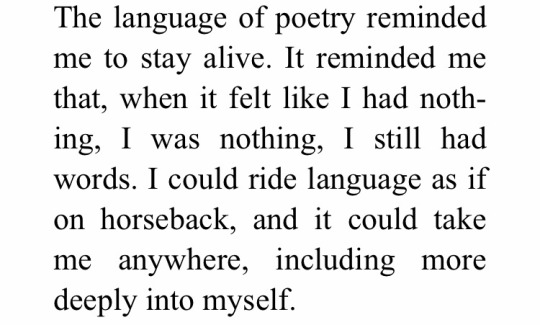
Victoria Chang, from Dear Memory: Letters on Writing, Silence, and Grief; “Dear Teacher,”
[Text ID: “The language of poetry reminded me to stay alive. It reminded me that, when it felt like I had nothing, I was nothing, I still had words. I could ride language as if on a horseback, and it could take me anywhere, including deeply into myself.”]
#victoria chang#on poetry#on language#excerpts#writings#literature#letters#prose#fragments#selections#words#quotes#typography#prose collection#letters collection
7K notes
·
View notes